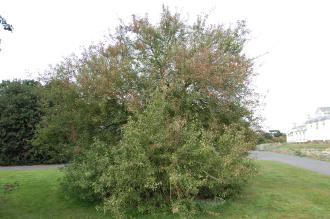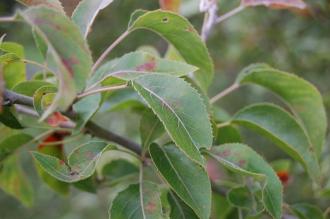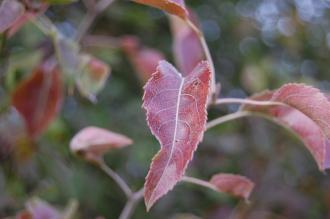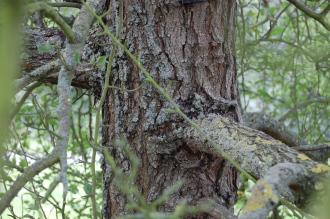
Pyrus betulaefolia (28/09/2014, Kew Gardens, London)
Position: Full sun to light shade
Flowering period: Spring
Soil: Moist, well drained
Eventual Height: 7.5m
Eventual Spread: 5m
Hardiness: 4b, 5a, 5b, 6a, 6b, 7a, 7b, 8a, 8b
Family: Rosaceae

Pyrus betulaefolia Leaf (28/09/2014, Kew Gardens, London)
Pyrus betulaefolia is a deciduous tree with a broadly pyramidal habit. Its glossy mid green leaves are ovate with serrate margins, up to 7cm long and 4cm broad. Its leaves turn red/ purple in autumn before they fall. Its white hermaphrodite flowers are up to 3cm across. Its green/ yellow fruit is a spherical pome and matures is autumn.
Pyrus betulaefolia, commonly known as Birch Leafed Pear, is native to east Asia to north China.

Pyrus betulaefolia Autumn Leaf (28/09/2014, Kew Gardens, London)
The etymological root of the binomial name Pyrus is the classical name for the Pear tree. Betulaefolia is derived from the name of another species of tree, Betula and the Latin folia meaning ‘leaf’.
The landscape architect may find Pyrus betulaefolia useful as an attractive spring flowering tree with interesting leaf color in autumn. This tree is tolerant of atmospheric pollution. Once established this tree is moderately drought tolerant.

Pyrus betulaefolia Bark (28/09/2014, Kew Gardens, London)
Ecologically, Pyrus betulaefolia flowers are attractive to pollinating insects. The fruit of this tree is attractive to some birds and mammals.
Pyrus betulaefolia prefers moist, fertile, well-drained soils. It tolerates most pH of soil.
Pyrus betulaefolia requires little maintenance.

